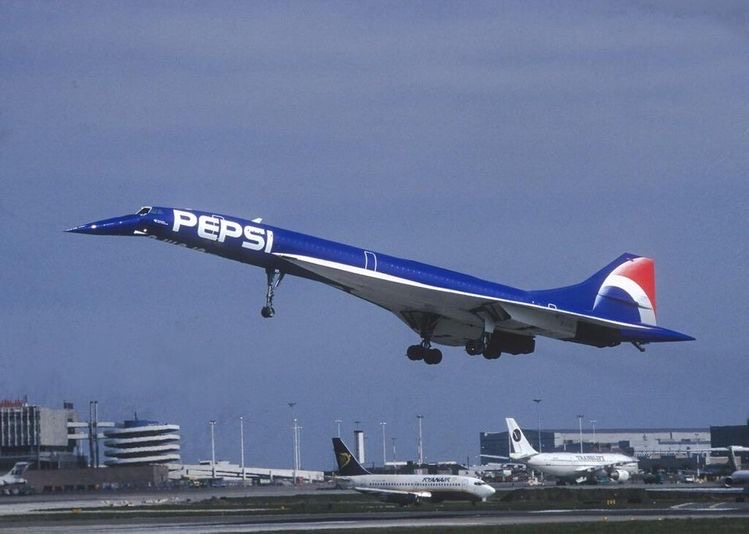In the mid-1990’s US soft drinks giant Pepsi was losing its market share to newly emerging rivals. The company, founded in 1898, planned a massive comeback dubbed ‘Project Blue,’ which included a complete rebranding of its products with its now-iconic blue and red colour scheme.

Bigger and better was the norm for marketing campaigns at the time and nothing was bigger and better than the world’s most iconic and fastest passenger jet – Concorde.
With $500 million to spend, the company approached British Airways and Air France to see who would be willing to decorate one of the multi-million-pound pride of their fleet like a giant Pepsi bottle for two weeks.

Air France was the eventual winner of the contract and in March 1996, work began on painting Concorde F-BTSD, dubbed ‘Sierra Delta’, in its new blue colour scheme at the airline’s maintenance facility at Paris Orly.
With the Pepsi logo on the tail and Pepsi titles along the fuselage, Air France was keen to let its passengers know that they were still flying on their aircraft, rather than one belonging to British Airways. Thus they added their name and logo under the cockpit window.

A Massive Drag
But the blue colour scheme had one massive drawback for a supersonic jet – it could only fly up to Mach 2.02 for 20 minutes at a time.
All Concorde’s are painted white. British Airways even adapted their Landor livery to suit their flagship jet. White paint reflects and radiates the heat that builds up on the aircraft’s fuselage as it flew far more effectively than darker colours. Suddenly an airline wanted to paint one dark blue. So Air France and Pepsi approached the plane’s designers Aérospatiale/BAC, to see if it could be done.
The manufacturer stipulated that the fuselage could be painted blue, although the wings would need to remain white to avoid any temperature changes to the fuel held in the wings. They also told the airline that the Concorde could fly no more than 20 minutes above the speed of sound as the darker paint would affect the aircraft’s ability to radiate heat. If it flew for longer, the fuselage would heat up beyond its limits, and it was likely that the paint would have melted or worse, combusted.

Two thousand hours and 200 litres of paint later, the Pepsi Concorde was ready. The whole process was to be kept top secret, and as the jet was painted, engineers covered it in brown wrapping paper to disguise its new colour scheme.

The Big Reveal
On March 31, 1996 under cover of darkness, the completed aircraft was flown from Paris Orly to London Gatwick. It would then be revealed to the world’s press and in the presence of superstars Claudia Schiffer, Andre Agassi and Cindy Crawford on April 2.

Pepsi’s Concorde would perform just 16 flights as part of a promotional tour across Europe and the Middle East, operating most flights at a non-supersonic Mach 0.7. However, it did break the sound barrier for a short time on most trips. These flights could be purchased by the public or were given away by Pepsi. Flight Attendants operating these flights each had a unique pin added to their uniform designed especially for the occasion.


Once Pepsi finished the marketing campaign, F-BTSD returned to Air France’s red, white and blue scheme and remained with the carrier until May 31, 2003 when it took its final flight from New York (JFK) to Paris Charles De Gaulle and, like the rest of the Concorde fleet, it was retired. The aircraft had flown 12,974 hours, completed 5,135 landings and 3,672 supersonic cycles. The jet was then flown to Le Bourget, where it now lives out its days alongside the prototype Concorde F-WTSS.

A Unique Airframe
Sierra Delta was also a historically significant Concorde for several other reasons. As well as wearing the unique Pepsi livery, it was also one of the final examples to be manufactured.
Delivered to Air France on September 18, 1978 it benefited from advanced construction techniques such as titanium rivets used to “add lightness,” totalling 2050 pounds in total weight savings compared to her sister aircraft.
It also holds both the westbound (32 hours 49 minutes and 3 seconds with six refuelling stops) and eastbound (31 hours 27 minutes 49 seconds with six refuelling stops) records for the fastest round-the-world commercial flights.
N.B. The author does not own the rights to any of the images included in this article unless otherwise stated.
© Jet Back In Time by Lee Cross.
